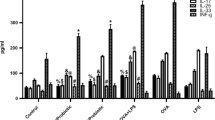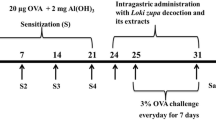Abstract
Introduction
Asthma is the most common chronic lower respiratory disease in childhood throughout the world. Recurrent respiratory tract infections in young children, especially viral infections, are the major cause of acute asthmatic exacerbations and contribute to development of asthma. Bacterial extracts have been used to improve the immune defenses of the respiratory tract. However, seldom studies have examined the effect of bacterial lysates on childhood asthma. In this study, we examined whether bacterial lysates (OM-85) will improve symptoms of asthmatic mice via modulation of the immune response.
Methods
Asthmatic mice models were established with OVA challenge and treated with oral administration of Broncho-Vaxom (OM-85). Next, infiltrations of inflammatory cells including eosinophil and neutrophils were examined. Pulmonary tissues in asthmatic mice models were analyzed by hematoxylin and eosin (HE) staining. The levels of Th1/Th2-typed cytokines in bronchoalveolar lavage fluid (BALF) of asthmatic mice models were examined by enzyme-linked immunosorbent assay.
Results
Compared to control group, we found significant reduction of airway wall thickness, luminal stenosis, and mucus plug formation in asthmatic mice models after oral administration of OM-85. The infiltrations of eosinophil were also significantly decreased in BALF in asthmatic mice models. Oral administration of OM-85 was shown to suppress Th2-type cytokine levels.
Conclusion
Our findings provide evidence that oral administration of OM-85 is capable of attenuating airway inflammation in asthmatic mice models. Oral administration of OM-85 may have a positive impact in terms of asthma severity.




Similar content being viewed by others
References
Kusel MM, de Klerk NH, Kebadze T et al (2007) Early-life respiratory viral infections, atopic sensitization, and risk of subsequent development of persistent asthma. J Allergy Clin Immunol 119(5):1105–1110
Sly PD, Kusel M, Holt PG (2010) Do early-life viral infections cause asthma? J Allergy Clin Immunol 125(6):1202–1205
Jackson DJ, Gangnon RE, Evans MD et al (2008) Wheezing rhinovirus illnesses in early life predict asthma development in high-risk children. Am J Respir Crit Care Med 178(7):667–672
Murray CS, Poletti G, Kebadze T et al (2006) Study of modifiable risk factors for asthma exacerbations: virus infection and allergen exposure increase the risk of asthma hospital admissions in children. Thorax 61(5):376–382
Heymann PW, Carper HT, Murphy DD et al (2004) Viral infections in relation to age, atopy, and season of admission among children hospitalized for wheezing. J Allergy Clin Immunol 114(2):239–247
Inoue Y, Shimojo N (2013) Epidemiology of virus-induced wheezing/asthma in children. Front Microbiol 16(4):391
Jackson DJ, Lemanske RF Jr (2010) The role of respiratory virus infections in childhood asthma inception. Immunol Allergy Clin N Am 30(4):513–522
Linder JE, Kraft DC, Mohamed Y et al (2013) Human rhinovirus C: age, season, and lower respiratory illness over the past 3 decades. J Allergy Clin Immunol 131(1):69–77
Forno E, Celedón JC (2012) Predicting asthma exacerbations in children. Curr Opin Pulm Med 18(1):63–69
Ahanchian H, Jones CM, Chen YS et al (2012) Respiratory viral infections in children with asthma: do they matter and can we prevent them? BMC Pediatr 13(12):147
Wu P, Hartert TV (2011) Evidence for a causal relationship between respiratory syncytial virus infection and asthma. Expert Rev Anti Infect Ther 9(9):731–745
Gern JE (2009) Rhinovirus and the initiation of asthma. Curr Opin Allergy Clin Immunol 9(1):73–78
De Benedetto F, Sevieri G (2013) Prevention of respiratory tract infections with bacterial lysate OM-85 bronchomunal in children and adults: a state of the art. Multidiscip Respir Med 8(1):33
Ahrens B, Quarcoo D, Buhner S et al (2011) Oral administration of bacterial lysates attenuates experimental food allergy. Int Arch Allergy Immunol 156(2):196–204
Lau S (2013) Oral application of bacterial lysate in infancy diminishes the prevalence of atopic dermatitis in children at risk for atopy. Benef Microbes 25:1–3
Lu Y, Li Y, Xu L et al (2015) Bacterial lysate increases the percentage of natural killer T cells in peripheral blood and alleviates asthma in children. Pharmacology 95(3–4):139–144
Vissers JL, van Esch BC, Hofman GA et al (2004) Allergen immunotherapy induces a suppressive memory response mediated by IL-10 in a mouse asthma model. J Allergy Clin Immunol 113(6):1204–1210
Ford JG, Rennick D, Donaldson DD et al (2001) Il-13 and IFN-gamma: interactions in lung inflammation. J Immunol 167(3):1769–1777
Sagar S, Verheijden KA, Georgiou NA et al (2013) Differential regulation of inflammation and immunity in mild and severe experimental asthma. Mediat Inflamm 2013:808470
Holgate ST (2012) Innate and adaptive immune responses in asthma. Nat Med 18(5):673–683
Bogaert P, Tournoy KG, Naessens T et al (2009) Where asthma and hypersensitivity pneumonitis meet and differ: noneosinophilic severe asthma. Am J Pathol 174(1):3–13
Fahy JV (2009) Eosinophilic and neutrophilic inflammation in asthma: insights from clinical studies. Proc Am Thorac Soc 6(3):256–259
Antoniu SA (2010) MEDI-528, an anti-IL-9 humanized antibody for the treatment of asthma. Curr Opin Mol Ther 12:233–239
Gauvreau GM, Boulet LP, Cockcroft DW et al (2011) Effects of interleukin-13 blockade on allergen-induced airway responses in mild atopic asthma. Am J Respir Crit Care Med 183:1007–1014
Mullane K (2011) Asthma translational medicine: report card. Biochem Pharmacol 82:567–585
Okayama Y (2013) Cellular and humoral immunity of virus-induced asthma. Front Microbiol 27(4):252
Jackson DJ, Lemanske RF Jr (2010) The role of respiratory virus infections in childhood asthma inception. Immunol Allergy Clin N Am 30(4):513–522
Dulek DE, Peebles RS Jr (2011) Viruses and asthma. Biochim Biophys Acta 1810(11):1080–1090
Podleski WK (1985) Immunomodulation of allergic autocytotoxicity in bronchial asthma by a bacterial lysate–Broncho-Vaxom. Int J Immunopharmacol 7(5):713–718
Weinberger M (2010) Can we prevent exacerbations of asthma caused by common cold viruses? J Allergy Clin Immunol. 126(4):770–771
Schaad UB (2010) OM-85 BV, an immunostimulant in pediatric recurrent respiratory tract infections: a systematic review. World J Pediatr 6(1):5–12
Razi CH, Harmancı K, Abacı A et al (2010) The immunostimulant OM-85 BV prevents wheezing attacks in preschool children. J Allergy Clin Immunol 126(4):763–769
Rozy A, Chorostowska-Wynimko J (2008) Bacterial immunostimulants—mechanism of action and clinical application in respiratory diseases. Pneumonol Alergol Pol 76(5):353–359
Strickland DH, Judd S, Thomas JA et al (2011) Boosting airway T-regulatory cells by gastrointestinal stimulation as a strategy for asthma control. Mucosal Immunol 4:43–52
Navarro S, Cossalter G, Chiavaroli C et al (2011) The oral administration of bacterial extracts prevents asthma via the recruitment of regulatory T cells to the airways. Mucosal Immunol 4:53–65
Fu R, Li J, Zhong H, Yu D et al (2014) Broncho-Vaxom attenuates allergic airway inflammation by restoring GSK3β-related T regulatory cell insufficiency. PLoS One 9(3):e92912
Author information
Authors and Affiliations
Corresponding author
Ethics declarations
Conflict of interest
The authors declare that the research was conducted in the absence of any commercial or financial relationships that could be construed as a potential conflict of interest. This research involved animals. The study was approved by the Hospital Ethics Committee.
Rights and permissions
About this article
Cite this article
Liu, C., Huang, R., Yao, R. et al. The Immunotherapeutic Role of Bacterial Lysates in a Mouse Model of Asthma. Lung 195, 563–569 (2017). https://doi.org/10.1007/s00408-017-0003-8
Received:
Accepted:
Published:
Issue Date:
DOI: https://doi.org/10.1007/s00408-017-0003-8




